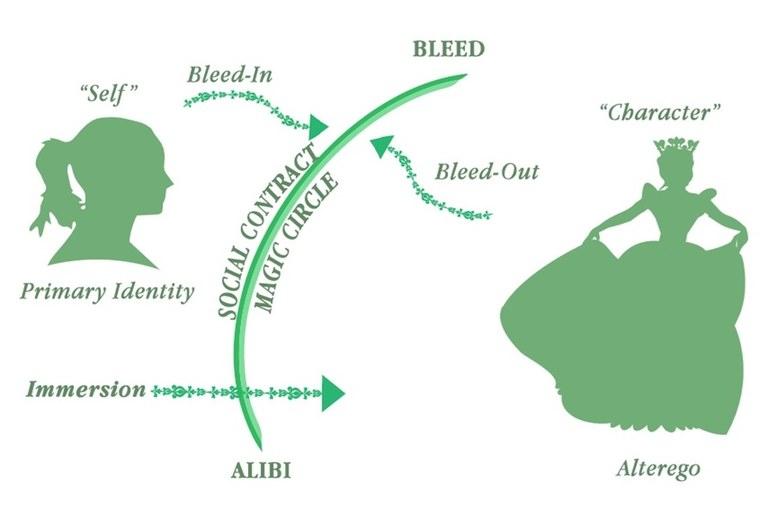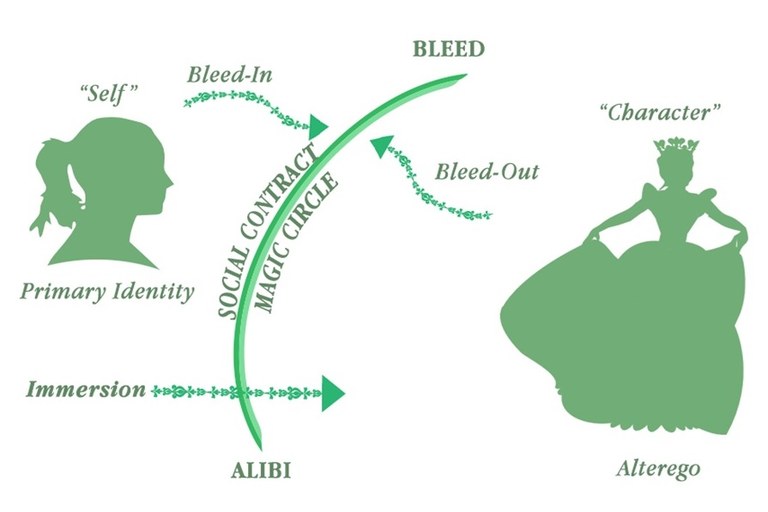Role-Playing Game RPG Research - What is Role-Playing Game "Bleed"?
Bleed Theory in Games - Part 1 by Erik Mitchell, RPG Research

Previous article location: https://w3.rpgresearch.com/blog/bleed-part-1-by-erik-mitchell
Role-playing gaming & Bleed Part 1 by Erik Mitchell of RPG Research
First in a series by Erik Mitchell on Role-Playing Games and the concept of "Bleed".
Originally posted to Patreon supporters February 9th, 2019 1:44 pm. https://www.patreon.com/posts/24588606
Posted publicly on w3.rpgresearch.com June 18th, 2019.
This is Part 1: https://rpgresearch.com/blog/rpg-research-community-blog-1/post/what-is-role-playing-game-bleed-11
Read Part 2 with this link: https://rpgresearch.com/blog/rpg-research-community-blog-1/post/what-is-role-playing-game-bleed-part-2-12
Preamble
The blog posting is a little farther down on this page if you want to skip the preamble.
RPG Research now has half a dozen (and growing) volunteer research asistants across several continents. As they are training up we ask that they "give back to the community" by at least:
- Posting 1 research related blog posting per month
- Creating 2 more formal research essays per year
- Participate in one group research project per year
It has taken a few months to work out the processes, but we now have a rudimentary internal peer review of all submissions, that passes through all of the other researches at least twice around, before finally coming to Hawke Robinson for final reviews, and then being eligible for posting.
Blog posting are intentionally designed to be more casual in voicing and style. They are often "thinking aloud" and "sharing experiences", but may lead to a series of building topics that may turn into their more formal research paper or project later on.
RPGSN (Role-Playing Gamers Social Network) members help also with the preview and final release phase.
Essays may have a release delay if they are accepted to be published by open journals.
Blog postings have no such delay, and go through our normal thank you release cycle:
Patreon $25+ level supporters get the first immediate access to the finished products.
A week or so later $10+/mo level supporters get access
A week after that the rest of the Patreon supporters.
Finally, at least a month (or more) after that, the item is available to the general public.
Here is the first of many in the pipe. Erik Mitchell is in Spokane Washington with an engineering and biological science background. See his biography here:
https://www.rpgresearch.com/about/about-rpg-research/our-staff/erik-mitchell
His first blog posting is on Bleed in Role-Playing Games. We hope you enjoy!
Bleed and Role-Playing Games an RPG Research Blog Posting by Erik Mitchell
Copyright RPG Research and Erik Mitchell (c) 2019
Abstract
This document examines the phenomena of bleed in relation with Role-Playing gaming. Bleed is a concept which describes aspects of the player’s self coming out in a game character and vice versa. I was looking to find out how bleed affected players in general when in an RPG session. The answer is good, bad, and everywhere in between. Please keep in mind, this article is a less formal blog post. The purpose of this posting is to invite discussion, so your comments are welcomed.
Role-playing Gaming & Bleed Part 1
Blog Post by Erik Mitchell of RPG Research
Imagine, for a moment, a group of friends casually playing a tabletop RPG. The group has been together for months. Everyone is well vested in the campaign, and they are making progress toward their shared goal of defeating a menacing villain. They roll their dice, vanquish their enemies, and make bold decisions, narrowly avoiding utter demise. On the surface, all seems well, however, unbeknown to the players, something was about to happen that would change the course of the game and their lives.
That is: The GM turned to a girl and yelled at her, in a character’s boisterous voice, as if he was speaking to her character. The girl was taken aback. She felt a wave of strong emotions such as anger, confusion, and hurt. The emotional rollercoaster she experienced made her withdraw inward. Her friends were suddenly and irrevocably removed from her life. Friendships were quickly ended, and the gaming group was left shattered.
“How could something like this happen?” you may find yourself inquiring. “If this just happened in a game, how could something that simple have caused such a profoundly negative reaction?” The answer, quite simply, is the topic of today’s post: the phenomenon known as bleed.
Bleed is a concept I never really had a name for until it was described by RPG Research founder, Hawke Robinson. As I will be discussing here, bleed refers to the emotional, psychological, and physical states that can transfer between real life and fantasy (Bowman, 2015). This fantasy could refer to a number of things, but I will be discussing role-playing gaming in this article. To better understand bleed, let’s take a look at this diagram from an article focusing on bleed in LARP (Live Action Role-Playing) (Bowman 2015):
As shown here, when role-playing, there is an inherent distinction between the player (self) and the player’s character.
This is separated by an imaginary boundary known as the magic circle which is created by the "rules, identities, and occurrences within the game space" (Montola 2012, as cited in Bowman, 2015). The line in the center, the "alibi", is the idea that actions inside the game are a representation of the character and not the player's self; the idea that a player would say or think "that was my character's choice, not mine". This forms a “magic circle,” by way of the alibi, that clearly separates the player’s world and the character’s. Bleed is, therefore, any interaction inside or outside of the game that causes this "magic circle" to be breached. Bleed that spills from a character to the self is known as “Bleed-out” and from the self to a character is “Bleed-in”. This can include anything from a moment of real-life empathy toward a wrongfully slain NPC to complete anger at another player for a betrayal between characters.
There are a couple kinds of bleed that will be discussed: negative and positive bleed. First, there is the kind of bleed that you are probably aware of: Negative bleed. This is the concept that something will bleed in or bleed out of a game and cause something bad to happen. The example given in the introduction, a player removing themselves not only from the game but from the real-life group of friends, is a very strong example of negative bleed. Without understanding or knowing the terminology, people unfamiliar with RPGs, and groups like B.A.D.D. (Bothered About Dungeons & Dragons), have expressed their fears about this kind of bleed. This includes misinformed ideas about playing a violent character leading to an increase in real life violence. Negative bleed, however, does not have to be this extreme. Negative bleed can happen in varying scenarios, such as: feelings of loss after losing a character’s friend in game, playing a character lazily (not role-playing or not participating) when the real-life self is sick, or even feeling more emotional because of your GM’s shirt color.
Second, there is positive bleed. This kind of bleed is less obvious and less discussed because it is not something that has been widely presented in media. Positive bleed is the concept that something will bleed in, or bleed out, of a game and cause something good to happen. Positive bleed is often associated with personal growth or learning. This could include learning to feel empathetic toward another person because you have lived their experience through a character. Positive bleed is the focus of many therapeutic RPG endeavors. Positive bleed shows that people from all walks of life can better learn to control and anticipate the outcome of situations, both in game and out, in a safe and controlled environment. This process is referred to as generalization: basically, when skills from a therapeutic bubble are applied to and used by the self, outside of the game.
Now, just because there are two main types of bleed, does not mean they are mutually exclusive. Every game session has the potential for both positive and negative bleed. Take this hypothetical example: A character experiences positive bleed-in when their real-life self learns new techniques in physics. After declaring that they’d like to build a makeshift trebuchet to launch themselves over the enemy fortress, they feel elated that their calculations and trajectory have been found to be plausible. The rolls are in their favor and their entire team is launched up over the wall, landing heroically inside enemy territory. Although, perhaps too heroically. Their characters (and therefore, their selves) forgot to consider what might result from landing after being catapulted. The characters all break various bones and one even ends up unconscious. The party is utterly overwhelmed and defeated. Feelings of elation might swing harshly to disappointment, as is normal for the game. If the players then start to take it out on themselves, the other players, or the GM, then we consider this bleed.
There are many paths available to bleed in this example. On the negative end, players might feel ashamed about their lack of forethought, they may feel animosity toward the player who suggested the idea, or they may feel animosity toward the GM, who they feel did not properly reward their creativity. On the positive end, even though the characters were defeated, they may, in the future, more carefully consider the ramifications of their action, they may be happy to have carried out a cool idea even if it failed massively, or they could feel inspired to figure out how to conquer not only the game itself but their GM as well. The players could feel any or all of these feelings at the same time and to varying degrees, some qualifying as bleed, even though; some of these emotions seem contradictory.
This is the major issue with defining “bleed”. Although every player may experience the sequence of events in the exact same manner, not every player will respond in the exact same way. Something positive for one person may be profoundly negative for another. Martin (2017) described a situation where he had a very strongly negative bleed reaction in a pickup game. The situation involved another player walking up to a cave with an NPC guard and he “cut him down without so much as a word.” The author said he “lost it a little” and proceeded to get carried away by a wave of emotion. He admitted that his reaction was in large part due to his own convictions, although he also chose a character that aligned well with his ideals. He almost walked away from the table after not only trying to kill the other player’s character, to stop the slaughter, but also confronting the other player directly about his style of play. Ultimately, Martin was convinced to stay by the GM. He found the killing profoundly negative, the other player, obviously, did not.
Luckily, there are a couple of ways to maintain balance in gaming as well. In the previous example, the GM “managed some fantastic story wizardry, … and the rest of the [game session] slot was fun.” The GM recognized that there was an issue and drove the story in a different direction, one that was fun for all the players.
Although I haven’t found much research on it yet, I get the feeling that bleed can be directed/mitigated/enhanced by a good GM, but that’s a whole topic on its own. In the Nordic LARP article Bleed: How Emotions Affect Role-Playing Experiences (Bowman, 2015), the author discusses several strategies to mitigate negative bleed. They use in-game signaling, de-roleing, and debriefing, to name just a few. In-game signaling involves using hand signals to call for emotional breaks and to show that they can/cannot continue. De-roleing includes a ritualistic way to “cast aside the role” and step into “their former identity”. Debriefing is a “formal space after the game for players to express their feelings and share stories in a serious manner” which can help mitigate and contextualize their bleed. RPG Research uses the term from the therapeutic recreation profession calling it “processing”, a facilitation approach designed to facilitate learning, awareness, and change. They also have social gatherings to help people connect out of game and writing, such as journaling, to allow expression. These are specific to the Nordic LARP community but can easily be applied to tabletop RPGs.
In the original example, if there had been an outlet to express and mitigate the damage from negative bleed, there may not have been as strong an emotional response. In fact, using some form of the bleed handling techniques above may turn even negative bleed into positive bleed. Perhaps openness about the emotional response felt by Martin (2017) could have been productive “both in mitigating his anger and helping the other player understand the effect of the choices he made.”
Finally, as previously indicated, positive bleed is the focus of therapeutic applications of RPGs. There’s an anecdote that RPG Research’s founder, Hawke Robinson, has brought up a few times about an at-risk youth, about 15 years old, playing a tabletop RPG for the first time. He very quickly, in just 45 minutes, manages to get his character killed. When the realization hits him that he can no longer play, he was brought near to tears. He learned that his actions had real in-game consequences and he could no longer act mindlessly. Fortunately, he was allowed to take over the character from one of our other volunteer players, and he completely changed his play style, including his attitude outside of the game, in a productive way. Positive bleed could also foster other social skills, such as building community in a workplace environment. Gaming can foster socialization in a controlled, safe environment, especially for those who would feel unsafe otherwise. Games can be tailored for specific educational goals as well, like helping people feel more connected to historical figures or events. There is still limited research available in the utilization of RPGs in therapeutics but that’s really what we’re here for and the observations of RPG Research have been very positive.
So, there it is, the basic working of bleed and a little bit about how it affects us as players. Now, here’s the part of the blog where I digress and start wildly brainstorming with ideas about this topic. For example, what kind of expectation is realistic for players or GMs for bleed? Should groups actively discuss this, should they set ground rules, or can everyone be expected to have an implicit understanding of how to handle bleed situations? How can groups isolated from experienced gaming groups be presented with these concepts? Should GMs actively be trying to control the flow of bleed? Would it be irresponsible to continue a strong story because the bleed negatively affected the group? At what point does GM magic harm players ability to learn through consequence (can a change of consequence drive an externalization of focus)? Maybe I’ll try to get a better understanding of these topics from opinions in various communities. Until then, I hope you enjoyed this initial delve into the concept of bleed, and I look forward to your comments.
Until next time!
Erik
References
nordiclarptalks. (2013, April 18). Bleed: How Emotions Affect Role-Playing Experiences - Sarah
Lynne Bowman [Video file]. Retrieved from
https://www.youtube.com/watch?v=AtjeFU4mxw4
Bowman, S. L. (2015, March 2). Bleed: The Spillover Between Player and Character. Retrieved
from http://nordiclarp.org/2015/03/02/bleed-the-spillover-between-player-and-character
Martin, P. (2017, July 4). Going on Tilt [Blog Post]. Retrieved from http://stgcast.org/going-on-tilt/
Martin, P. (2016, March 1). Theoretical RPG Concepts: Bleed [Blog Post]. Retrieved from
http://stgcast.org/theoretical-rpg-concepts-bleed/

Hawke Robinson
Known across multiple industries as "The Grandfather of Therapeutic Gaming" because he has been studying the effects and uses of role-playing games and their potential to achieve therapeutic goals longer than anyone else, Hawke Robinson is a Washington State Department of Health Registered Recreational Therapist.
He has a diverse and deep background in Therapeutic Recreation / Recreation Therapy, computer science, neuroscience, cognitive neuropsychology, neurotech, research psychology, nursing, play therapy, education, music, and role-playing gaming.
- Hawke Robinson has been involved with role-playing games in community settings since 1977.
- Studying methods for optimizing the experience of role-playing games, software development, and online since 1979.
- A paid professional game master since 1982.
- Studying the effects of role-playing games upon participants since 1983.
- Providing role-playing games in educational settings and for educational goals since 1985.
- Working with incarcerated populations since 1989.
- Researching and using role-playing games to achieve therapeutic goals for a wide range of populations from 2 years old through senior adults since 2004.
- Founder and Executive Director of the non-profit 501(c)3 charitable research and human services organization, RPG Research.
- Founder and CEO of the for-profit RPG Therapeutics LLC and RPG.LLC.
- Author of multiple books in technology and gaming W.A. Hawkes-Robinson books available on Amazon.
- Creator of the wheelchair accessible RPG Mobile fleet vehicles and trailers.
- Founder of the experiential learning Role-Playing Game RPG Museum, and much more.
- Creator of the Brain-Computer Interface Role-Playing Game (BCI RPG) and many other related projects.

No comments yet. Start a new discussion.